Leadership Self-Assessment: Impact of Strengths and Weaknesses
VerifiedAdded on 2020/03/02
|5
|998
|37
Homework Assignment
AI Summary
This assignment presents a self-assessment of leadership capabilities, evaluating both strengths and weaknesses. The assessment highlights key strengths, including strong interpersonal skills, effective decision-making, high energy levels, integrity, and good problem-solving abilities. It also identifies areas for improvement, such as verbal communication skills and managing temper. The analysis emphasizes the impact of these attributes on leadership effectiveness and organizational performance. The assignment also provides references to support the findings and conclusions. The student aims to improve leadership skills by understanding these strengths and weaknesses.
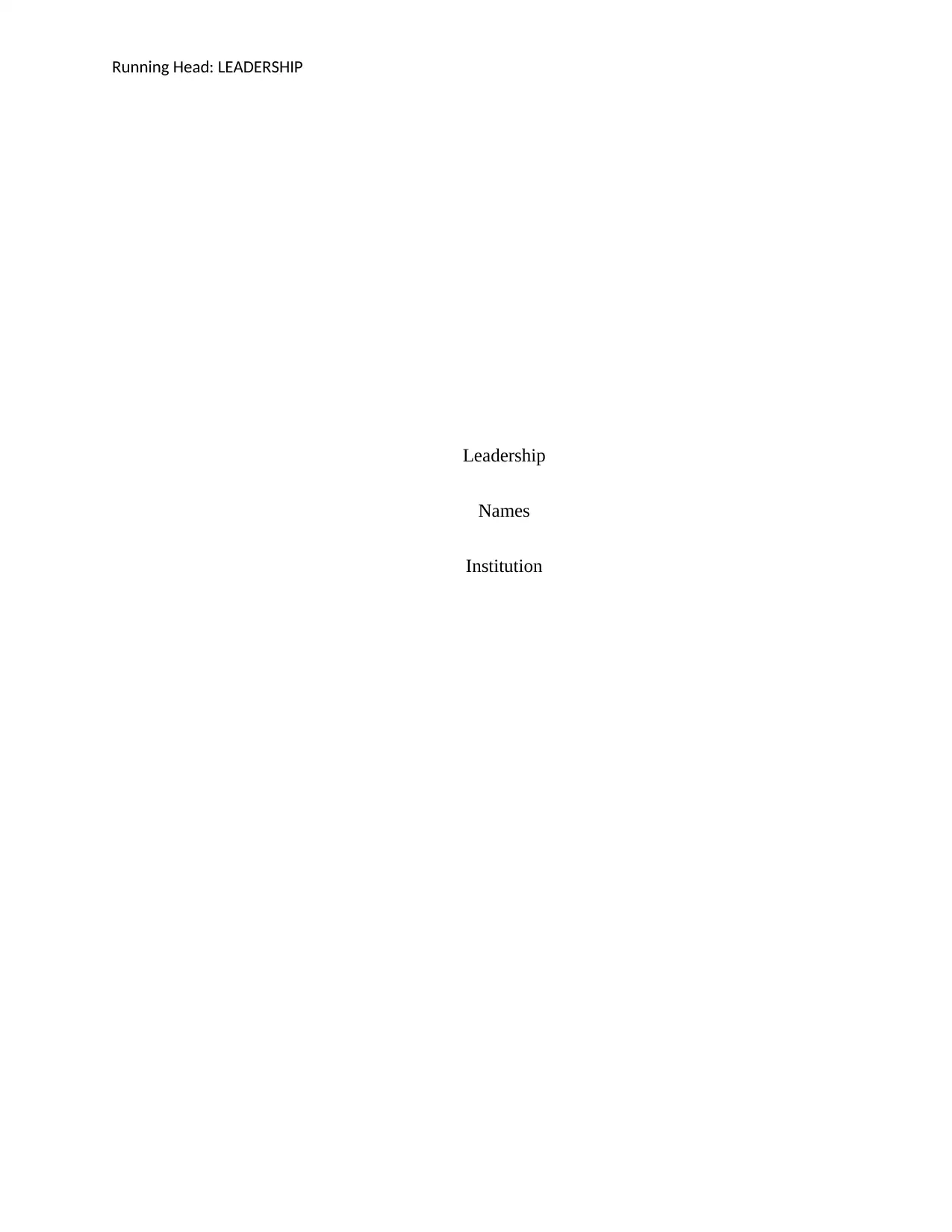
Running Head: LEADERSHIP
Leadership
Names
Institution
Leadership
Names
Institution
Paraphrase This Document
Need a fresh take? Get an instant paraphrase of this document with our AI Paraphraser
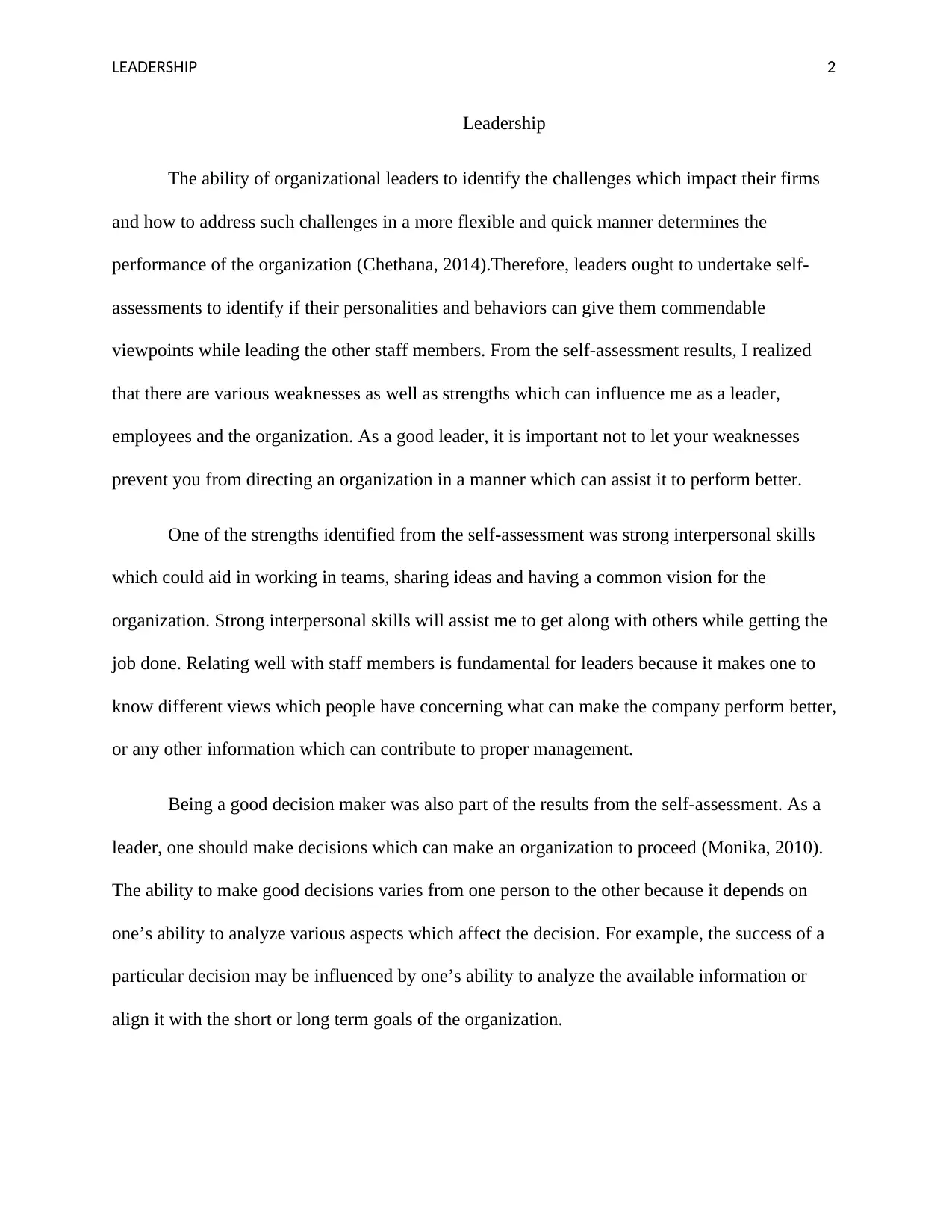
LEADERSHIP 2
Leadership
The ability of organizational leaders to identify the challenges which impact their firms
and how to address such challenges in a more flexible and quick manner determines the
performance of the organization (Chethana, 2014).Therefore, leaders ought to undertake self-
assessments to identify if their personalities and behaviors can give them commendable
viewpoints while leading the other staff members. From the self-assessment results, I realized
that there are various weaknesses as well as strengths which can influence me as a leader,
employees and the organization. As a good leader, it is important not to let your weaknesses
prevent you from directing an organization in a manner which can assist it to perform better.
One of the strengths identified from the self-assessment was strong interpersonal skills
which could aid in working in teams, sharing ideas and having a common vision for the
organization. Strong interpersonal skills will assist me to get along with others while getting the
job done. Relating well with staff members is fundamental for leaders because it makes one to
know different views which people have concerning what can make the company perform better,
or any other information which can contribute to proper management.
Being a good decision maker was also part of the results from the self-assessment. As a
leader, one should make decisions which can make an organization to proceed (Monika, 2010).
The ability to make good decisions varies from one person to the other because it depends on
one’s ability to analyze various aspects which affect the decision. For example, the success of a
particular decision may be influenced by one’s ability to analyze the available information or
align it with the short or long term goals of the organization.
Leadership
The ability of organizational leaders to identify the challenges which impact their firms
and how to address such challenges in a more flexible and quick manner determines the
performance of the organization (Chethana, 2014).Therefore, leaders ought to undertake self-
assessments to identify if their personalities and behaviors can give them commendable
viewpoints while leading the other staff members. From the self-assessment results, I realized
that there are various weaknesses as well as strengths which can influence me as a leader,
employees and the organization. As a good leader, it is important not to let your weaknesses
prevent you from directing an organization in a manner which can assist it to perform better.
One of the strengths identified from the self-assessment was strong interpersonal skills
which could aid in working in teams, sharing ideas and having a common vision for the
organization. Strong interpersonal skills will assist me to get along with others while getting the
job done. Relating well with staff members is fundamental for leaders because it makes one to
know different views which people have concerning what can make the company perform better,
or any other information which can contribute to proper management.
Being a good decision maker was also part of the results from the self-assessment. As a
leader, one should make decisions which can make an organization to proceed (Monika, 2010).
The ability to make good decisions varies from one person to the other because it depends on
one’s ability to analyze various aspects which affect the decision. For example, the success of a
particular decision may be influenced by one’s ability to analyze the available information or
align it with the short or long term goals of the organization.
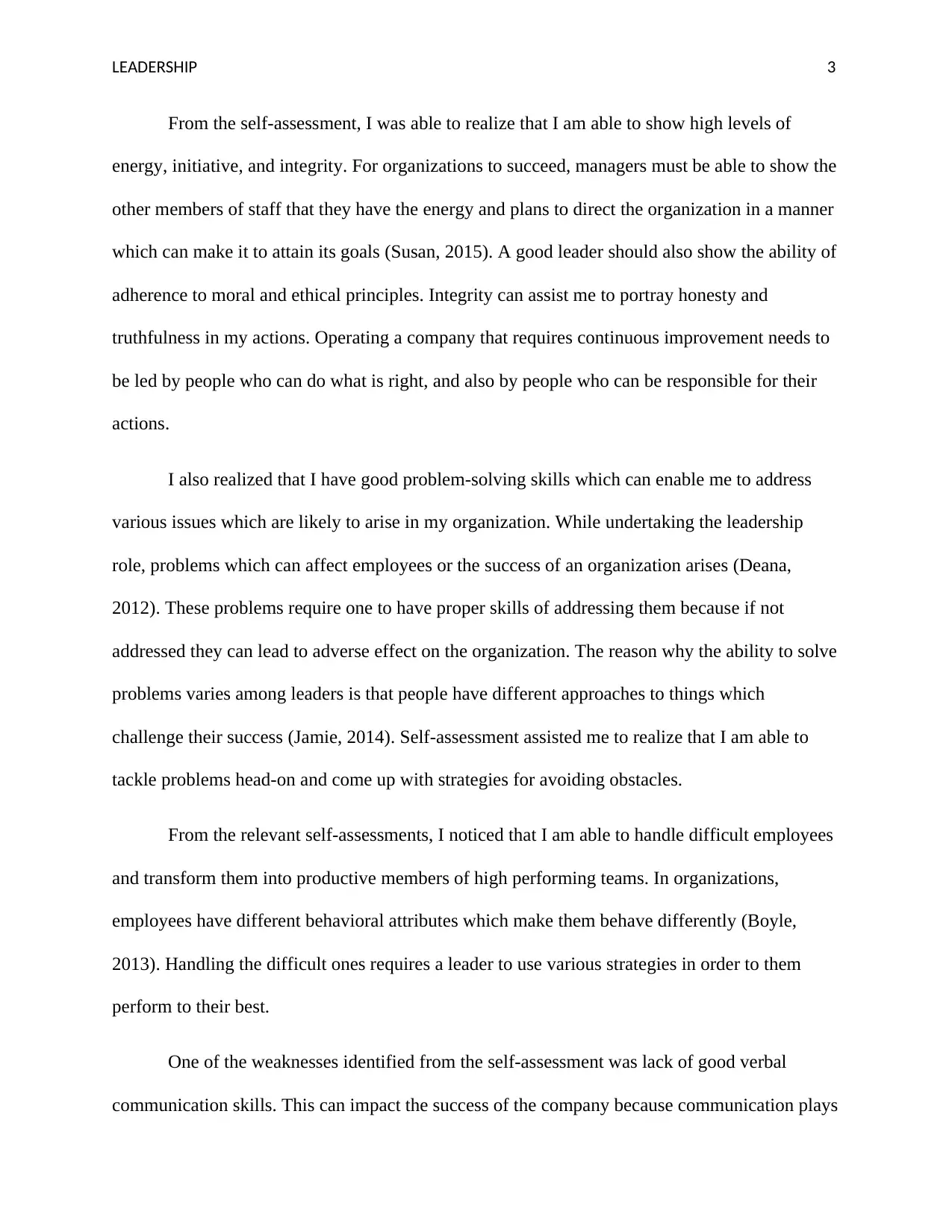
LEADERSHIP 3
From the self-assessment, I was able to realize that I am able to show high levels of
energy, initiative, and integrity. For organizations to succeed, managers must be able to show the
other members of staff that they have the energy and plans to direct the organization in a manner
which can make it to attain its goals (Susan, 2015). A good leader should also show the ability of
adherence to moral and ethical principles. Integrity can assist me to portray honesty and
truthfulness in my actions. Operating a company that requires continuous improvement needs to
be led by people who can do what is right, and also by people who can be responsible for their
actions.
I also realized that I have good problem-solving skills which can enable me to address
various issues which are likely to arise in my organization. While undertaking the leadership
role, problems which can affect employees or the success of an organization arises (Deana,
2012). These problems require one to have proper skills of addressing them because if not
addressed they can lead to adverse effect on the organization. The reason why the ability to solve
problems varies among leaders is that people have different approaches to things which
challenge their success (Jamie, 2014). Self-assessment assisted me to realize that I am able to
tackle problems head-on and come up with strategies for avoiding obstacles.
From the relevant self-assessments, I noticed that I am able to handle difficult employees
and transform them into productive members of high performing teams. In organizations,
employees have different behavioral attributes which make them behave differently (Boyle,
2013). Handling the difficult ones requires a leader to use various strategies in order to them
perform to their best.
One of the weaknesses identified from the self-assessment was lack of good verbal
communication skills. This can impact the success of the company because communication plays
From the self-assessment, I was able to realize that I am able to show high levels of
energy, initiative, and integrity. For organizations to succeed, managers must be able to show the
other members of staff that they have the energy and plans to direct the organization in a manner
which can make it to attain its goals (Susan, 2015). A good leader should also show the ability of
adherence to moral and ethical principles. Integrity can assist me to portray honesty and
truthfulness in my actions. Operating a company that requires continuous improvement needs to
be led by people who can do what is right, and also by people who can be responsible for their
actions.
I also realized that I have good problem-solving skills which can enable me to address
various issues which are likely to arise in my organization. While undertaking the leadership
role, problems which can affect employees or the success of an organization arises (Deana,
2012). These problems require one to have proper skills of addressing them because if not
addressed they can lead to adverse effect on the organization. The reason why the ability to solve
problems varies among leaders is that people have different approaches to things which
challenge their success (Jamie, 2014). Self-assessment assisted me to realize that I am able to
tackle problems head-on and come up with strategies for avoiding obstacles.
From the relevant self-assessments, I noticed that I am able to handle difficult employees
and transform them into productive members of high performing teams. In organizations,
employees have different behavioral attributes which make them behave differently (Boyle,
2013). Handling the difficult ones requires a leader to use various strategies in order to them
perform to their best.
One of the weaknesses identified from the self-assessment was lack of good verbal
communication skills. This can impact the success of the company because communication plays
⊘ This is a preview!⊘
Do you want full access?
Subscribe today to unlock all pages.

Trusted by 1+ million students worldwide
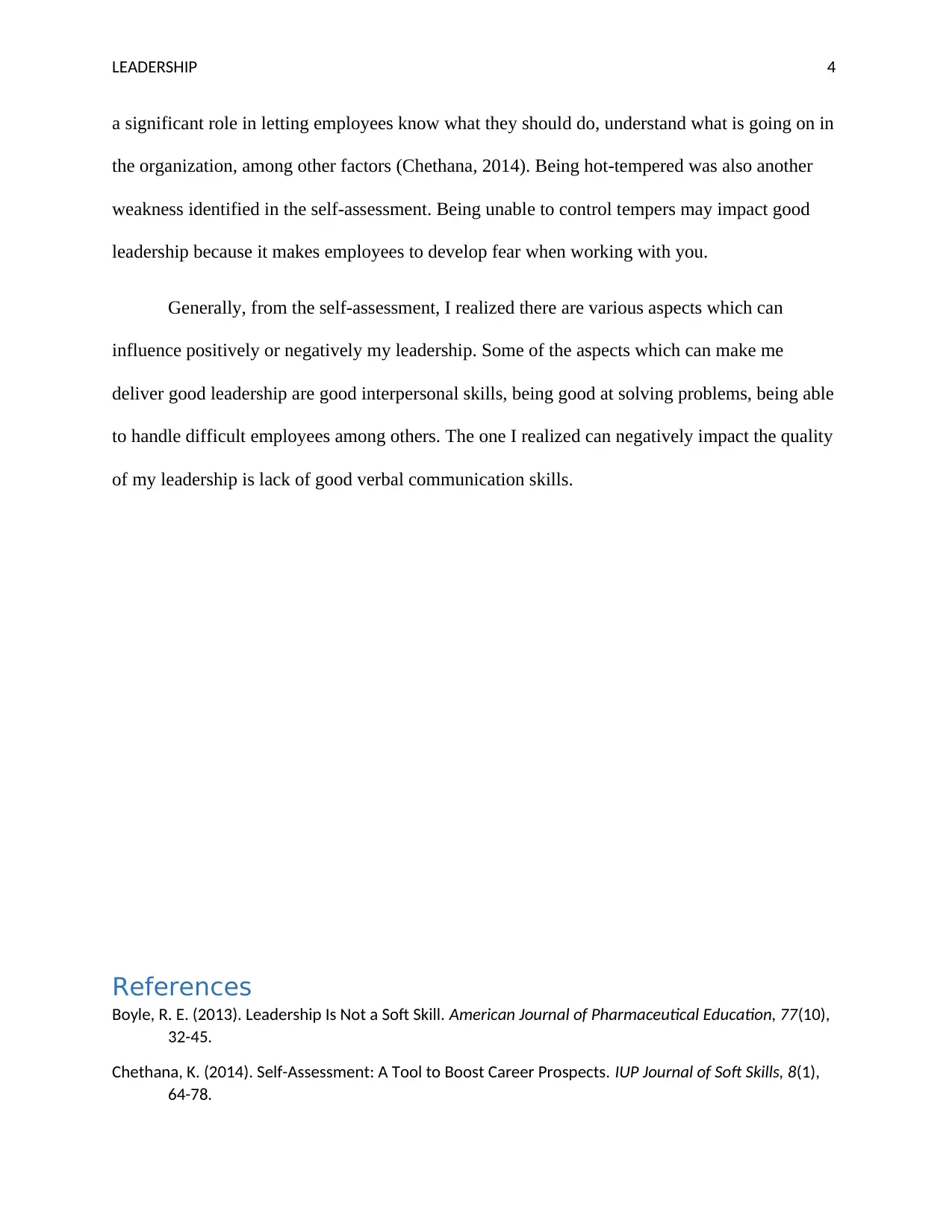
LEADERSHIP 4
a significant role in letting employees know what they should do, understand what is going on in
the organization, among other factors (Chethana, 2014). Being hot-tempered was also another
weakness identified in the self-assessment. Being unable to control tempers may impact good
leadership because it makes employees to develop fear when working with you.
Generally, from the self-assessment, I realized there are various aspects which can
influence positively or negatively my leadership. Some of the aspects which can make me
deliver good leadership are good interpersonal skills, being good at solving problems, being able
to handle difficult employees among others. The one I realized can negatively impact the quality
of my leadership is lack of good verbal communication skills.
References
Boyle, R. E. (2013). Leadership Is Not a Soft Skill. American Journal of Pharmaceutical Education, 77(10),
32-45.
Chethana, K. (2014). Self-Assessment: A Tool to Boost Career Prospects. IUP Journal of Soft Skills, 8(1),
64-78.
a significant role in letting employees know what they should do, understand what is going on in
the organization, among other factors (Chethana, 2014). Being hot-tempered was also another
weakness identified in the self-assessment. Being unable to control tempers may impact good
leadership because it makes employees to develop fear when working with you.
Generally, from the self-assessment, I realized there are various aspects which can
influence positively or negatively my leadership. Some of the aspects which can make me
deliver good leadership are good interpersonal skills, being good at solving problems, being able
to handle difficult employees among others. The one I realized can negatively impact the quality
of my leadership is lack of good verbal communication skills.
References
Boyle, R. E. (2013). Leadership Is Not a Soft Skill. American Journal of Pharmaceutical Education, 77(10),
32-45.
Chethana, K. (2014). Self-Assessment: A Tool to Boost Career Prospects. IUP Journal of Soft Skills, 8(1),
64-78.
Paraphrase This Document
Need a fresh take? Get an instant paraphrase of this document with our AI Paraphraser
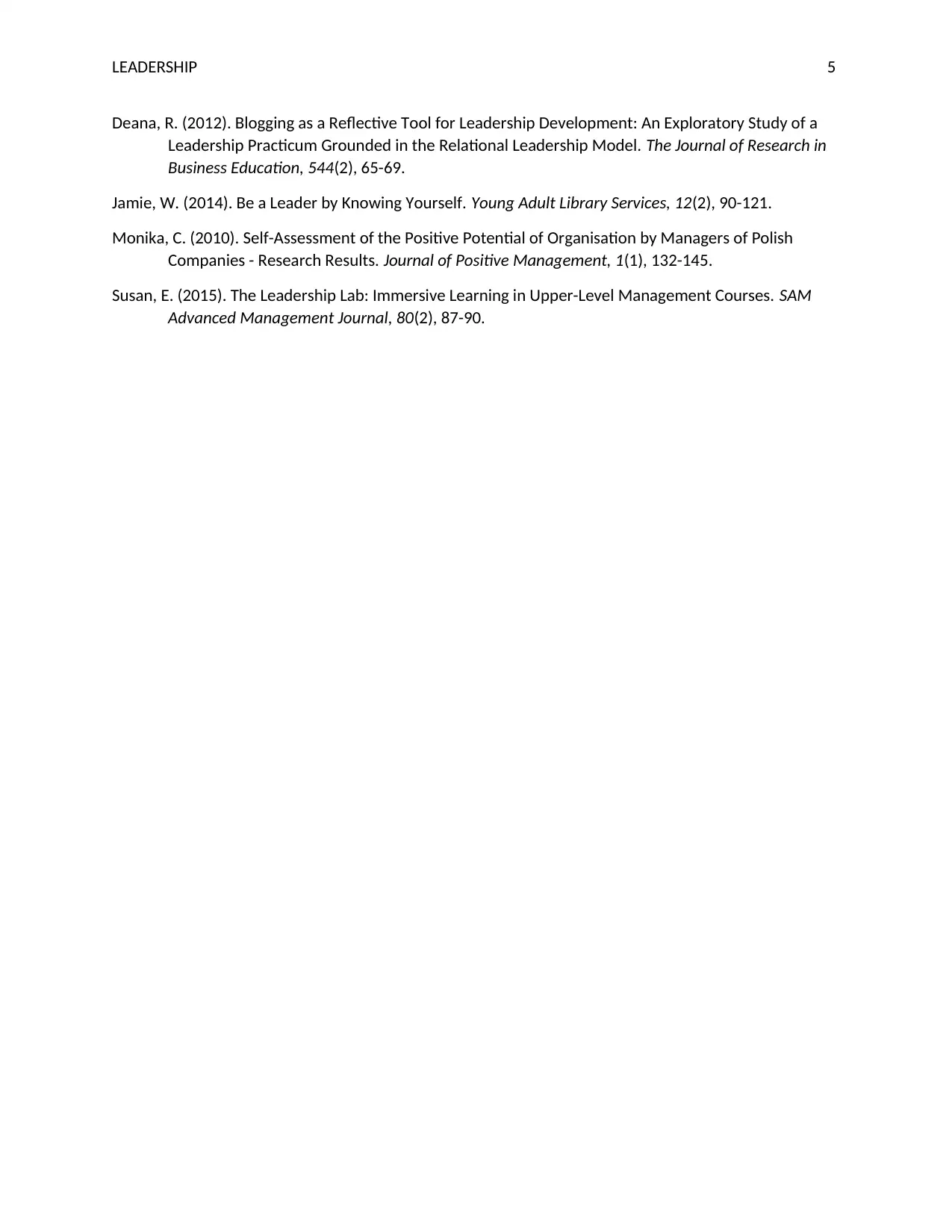
LEADERSHIP 5
Deana, R. (2012). Blogging as a Reflective Tool for Leadership Development: An Exploratory Study of a
Leadership Practicum Grounded in the Relational Leadership Model. The Journal of Research in
Business Education, 544(2), 65-69.
Jamie, W. (2014). Be a Leader by Knowing Yourself. Young Adult Library Services, 12(2), 90-121.
Monika, C. (2010). Self-Assessment of the Positive Potential of Organisation by Managers of Polish
Companies - Research Results. Journal of Positive Management, 1(1), 132-145.
Susan, E. (2015). The Leadership Lab: Immersive Learning in Upper-Level Management Courses. SAM
Advanced Management Journal, 80(2), 87-90.
Deana, R. (2012). Blogging as a Reflective Tool for Leadership Development: An Exploratory Study of a
Leadership Practicum Grounded in the Relational Leadership Model. The Journal of Research in
Business Education, 544(2), 65-69.
Jamie, W. (2014). Be a Leader by Knowing Yourself. Young Adult Library Services, 12(2), 90-121.
Monika, C. (2010). Self-Assessment of the Positive Potential of Organisation by Managers of Polish
Companies - Research Results. Journal of Positive Management, 1(1), 132-145.
Susan, E. (2015). The Leadership Lab: Immersive Learning in Upper-Level Management Courses. SAM
Advanced Management Journal, 80(2), 87-90.
1 out of 5
Related Documents
Your All-in-One AI-Powered Toolkit for Academic Success.
+13062052269
info@desklib.com
Available 24*7 on WhatsApp / Email
![[object Object]](/_next/static/media/star-bottom.7253800d.svg)
Unlock your academic potential
Copyright © 2020–2025 A2Z Services. All Rights Reserved. Developed and managed by ZUCOL.





